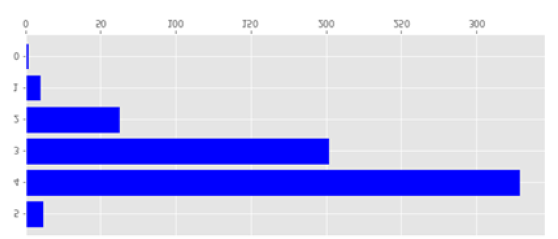- Submissions

Full Text
COJ Robotics & Artificial Intelligence
Building a Popularity Recommender for Movie Lens Dataset Using Python
Marappan R*
Senior Assistant Professor, India
*Corresponding author: Marappan R, School of Computing, SASTRA Deemed University, Thanjavur, India
Submission: June 14, 2022;Published: October 17, 2022

ISSN:2832-4463 Volume2 Issue3
Abstract
There are a lot of recommendation systems developed for different artificial intelligence and machine learning applications. The recommendation systems should provide a better recommendation with minimal computing time. This research focuses on how to build the popularity-based recommender system for the Movie Lens dataset using Python with its analysis.
Keywords: Recommendation systems; Recommender systems; Artificial intelligence; Machine learning; Popularity recommender
Introduction
Recently many recommender systems are developed for information filtering [1]. The learners or users are expected to get a better recommendation for their interests in various applications. This research focuses on developing a popularity-based recommender using Python.
Dataset Structure
For the implementation purpose, the Movie Lens dataset is considered with ratings.csv and movies.csv files [2-4]. The fields in movies.csv are movieId, title, and genre. The unique id for each movie is defined in movieId. The name of the movie is defined in the title field. The genre of the movie is defined in the genre field. The fields defined in ratings.csv are userId, movieId, rating, and timestamp. The users who are rated movies are defined in the unique userId. The movie ratings of the user are defined in the rating field. The time of rating a movie is defined in the timestamp field.
Python Model
This section focuses on the Python recommendation model for the Movie Lens dataset.
The structure of ratings.csv and movies.csv are sketched in Figure 1 & 2 respectively. The
combined structure of these files is shown in Figure 3. The complete model is defined as
follows:
#import all necessary libraries: os, numpy, pandas, matplotlib.pyplot
plt.style.use(‘seaborn-bright’)
%Matplotlib inline
#Change directory to the folder where data files are present
#This step is not necessary if the data files and jupyter notebook are in same folder
os.chdir(“E:\MovieLens”)
#Import ratings file in a pandas data frame
ratings_data=pd.read_csv(“ratings.csv”)
ratings_data.head()
movie_names = pd.read_csv(“movies.csv”)
movie_names.head()
m o v i e _ d a t a = p d . m e r g e ( r a t i n g s _ d a t a , m o v i e _ names,on=’movieId’)
movie_data.head()
Figure 1: Gamefinite login page.

Figure 2: Structure of movies csv.

Figure 3: Combined structure of ratings.csv & movies.csv with movieId as the primary key.

Model Analysis
This section focuses on the analysis of the constructed model.
The ratings and the total ratings are shown in Figure 4 & 5. The
ratings with the number of movies are sketched in Figures 6-8.
The steps in Python model development for popularity-based
recommendation are as follows:
1. Define the packages: os, numpy and pandas
2. The working directory is to be changed to the dataset folder.
3. Read the information from the ratings.
4. Read the information from the movies file.
5. Merge ratings_data & movie_names using the pandas built-in
function.
6. Construct the data frame ‘movie_data’ and print it.
7. Plot a horizontal bar graph using matplotlib library to get an
overview of data.
8. Plot a bar graph to sketch the total number of reviews for each
movie individually.
9. Arrange the titles in the order to recommend top-rating
movies.
Figure 4:Rating and total ratings.

Figure 5:

Figure 6:Ratings with number of movies.

Figure 7:

Figure 8:

Conclusion
More users may review and rate some movies. To have a better recommendation, new rules should be added for better popularity prediction of a movie. In addition, the newer ones may be better than the existing ones. In these situations, more weight will be included in the rate of newer movies to bring to the recommendation list. In the future, new recommenders will be developed using evolutionary computing strategies [5-10].
References
- Ahn S, Kang J, Park S (2017) What makes the difference between popular games and unpopular games? analysis of online game reviews from steam platform using word2vec and bass model. ICIC Express Letters 11(12): 1729-1737.
- Bankov B (2019) The Impact of social media on video game communities and the gaming industry. Information and Communication Technologies in Business and Education, pp. 198-208.
- Kolo C, Baur T (2004) Living a virtual life: Social dynamics of online gaming. The International Journal of Computer Game Research 4(1): 1-30.
- Young CJ (2018) Game changers: Everyday game makers and the development of the video game industry. Digital Game Production, pp. 1-239.
- Curran K, George C (2012) The future of web and mobile game development. International Journal of Cloud Computing and Services Science 1(1): 25-34.
- De Prato G, Feijoo C, Jean-Paul S (2014) Innovations in the video game industry: Changing global markets. Digiworld Economic Journal pp. 1-22.
- Walat K (2019) Competitiveness of polish companies in the video game industry. pp. 133-152.
- Schofield D, LeDone R, Suny Oswego (2019) The motivations of a video game streamers and their viewers. Screen Thought 3(1): 1-13.
- Kanagal NB (2015) Innovation and product innovation in marketing strategy. Journal of Management and Marketing Research 18: 1-25.
- Dux J (2018) Social live-streaming: Twitch.TV and uses and gratification theory social network analysis. CS & IT Conference Proceedings, pp. 47-61.
© 2022 Samad Shibghatullah A. This is an open access article distributed under the terms of the Creative Commons Attribution License , which permits unrestricted use, distribution, and build upon your work non-commercially.
 a Creative Commons Attribution 4.0 International License. Based on a work at www.crimsonpublishers.com.
Best viewed in
a Creative Commons Attribution 4.0 International License. Based on a work at www.crimsonpublishers.com.
Best viewed in 







.jpg)






























 Editorial Board Registrations
Editorial Board Registrations Submit your Article
Submit your Article Refer a Friend
Refer a Friend Advertise With Us
Advertise With Us
.jpg)






.jpg)














.bmp)
.jpg)
.png)
.jpg)










.jpg)






.png)

.png)



.png)






